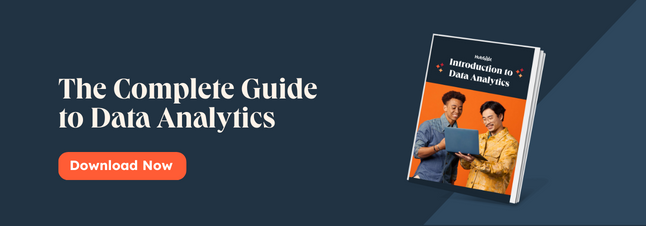5 Common Big Data Challenges
While the specific challenges you'll face with big data will depend on your organization's industry, infrastructure, and the types of data you're dealing with, these five core problems tend to show up repeatedly when managing data. Let's break down each one in detail.

1. You can't easily find the data you need.
The first challenge of big data analytics that a lot of businesses encounter is that big data is, well, big. There seems to be data for everything — customers' interests, website visitors, conversion rates, churn rates, financial data, and so much more.
While a lot of that data is extremely useful, there are huge chunks that aren't exactly relevant for your business. And, with the sheer amount of information available, it can be hard to decide what is valuable for your business and what isn't.
This problem typically presents itself if data is coming into your business unfiltered and unstructured through various different channels.
2. You're collecting inaccurate and/or outdated data.
If you have too much data in your databases, it's likely that somewhere along the line you've inadvertently collected inaccurate data, or that some of your data is no longer valid.
This problem starts at the collection process of your data lifecycle and is especially prevalent if your business is collecting data from a multitude of different sources and formats. If data collection isn't standardized across all channels, you can run into real problems when you need to analyze the data and extract insights from it.
This data is also collected from different apps that don't always “talk” to each other, looked at by several teams that don't have access to the full picture, and analyzed without any safeguards to ensure data quality, validity, and security.
In essence, poor data collection leads to low standards of quality and accuracy. And if you can't trust your data, you can't trust the analysis you get from it.
3. Your data is stored in silos.
Data silos are another big problem that can occur when dealing with big data.
If all of your information is stored in separate databases that don't communicate with each other, you've got data silos on your hands. What this means is that your teams aren't all looking at the same data, but instead only have access to a limited snippet that doesn't tell the whole story.

If your teams can only see a portion of the data, it can lead to poor execution — it could be the reason why your marketing and sales teams are misaligned, or why your customer service department misinterprets a customer’s needs.
Without a 360-degree view of your data, it's difficult to figure out how to build accurate, trustworthy reports and extract the best value.
Learn More About HubSpot's Operations Hub Software
4. Data security and protection are overlooked.
More data means more opportunity for security breaches. This problem is exacerbated when that data is less organized. As your business grows and you add new tools to your software stack, and deploy new technologies to make sense of your data, there is a heightened probability for lapses in security. Consider the following potential threats to your data security:
- Fake data generation. If you're gathering data from multiple sources indiscriminately, you might be gathering fake (and therefore invalid and potentially harmful) data. Fake and invalid data will affect any analysis you can get from it.
- Unsecured data sources. Gathering data from channels that aren't secure means that your systems are more vulnerable to external infiltration and potentially even malware.
- Unprotected stored data. When you store the data you've gathered without any safeguards — such as encryption, access control, and firewalls — this data becomes vulnerable to issues such as leaks, malware, and data harvesting, which would be extremely damaging to your business, not to mention your customers' privacy.
- Non-compliance to privacy laws. Without a proper strategy to ensure compliance with data protection laws — which includes protecting your data from bad actors — there's a much higher risk of exposure. In addition, without tracking and standardizing all the channels through which you gather data, you can't ensure that users are providing appropriate consent.
5. There's a shortage of qualified personnel in big data analytics.
It's common for businesses to have problems finding qualified people to organize, manage, and analyze big data.
The technology and tools around big data are advancing rapidly, but there aren't necessarily enough people who can operate this technology at an expert level. It's much harder to collect, manage, and build actionable reports from big data if your team simply doesn't have the know-how.
How to Create an Effective Big Data Strategy
We've tackled the potential challenges of big data analytics that your business can encounter, and you might have noticed a pattern in all of them: They stem from a lack of structured processes to collect, manage, and analyze data.
By creating a sound data strategy that clearly outlines who handles the data, where it comes from and where it goes, and how it moves within your systems, you'll be in the best position to derive actionable insights and create positive organizational change. Let's review some big data best practices to follow.

1. Audit your current data management process.
To start, it's a good idea to audit your current data management processes. Look at all the apps in your software stack that collect data, such as your CRM, email marketing app, and lead generation tool.
Some of these processes and tools might have been implemented when your company was at a totally different stage, which means that they might not be a good fit for where you are now.
A good big data strategy starts at the collection or creation stage. Make sure that all the data entering your systems is accurate and valid (e.g. make sure your forms only accept valid email addresses and phone numbers with the right amount of digits).
In addition, triple-check that no data is being entered by bots (you can use security technology, like reCAPTCHA, for this purpose) and that users are providing full consent for you to store and handle their data. Compliance with data protection and privacy laws is crucial.
2. Provide adequate training for your staff.
If you can't have a person or team that specializes in managing data for you, make sure your existing teams that handle it on a daily basis know what to do.
This can involve providing courses in data management and analytics, running data management bootcamps, and training them extensively in the tools you're using. If it's not feasible to hire new people to handle data — or if you can't find the talent — it's important to keep your whole team up to speed to reduce the occurrence of human error.
That said, data analytics doesn't have to be super complex.There are many tools, like Chartio and Tableau, that make it easy for anyone to easily access, analyze, and make decisions based on data.
3. Implement a sound data management strategy.
After auditing your current processes, you will hopefully have a much better idea of what works for your organization and what doesn't when it comes to data management. Take note of what areas need to be improved and which are doing well.
With this in mind, it's time to outline a new data management strategy. Your big data solution needs to fit your business now, but also in the future. Otherwise you'll run into problems again as you scale.
Cleaning up your databases is the first step in this strategy. You might need to scan your databases and erase all outdated, duplicate, and invalid data.
Then, build the best tech stack to store and manage data, introduce company-wide standards for data entry and maintenance, back up your data, and choose integration platforms to make sure your databases are connected and playing nicely together.
4. Integrate data for enriched databases.
One of the most important things you can do to make sure you get the most out of big data is integrating your databases. Without integration, no matter how good your data plan is, you will always end up with data silos and misaligned departments.
Besides, the best software stack in the world will never be 100% effective if it's not integrated. In fact, the most successful businesses run with tools that are integrated in real time, enabling everyone to have an accurate, updated and 360-degree view of every aspect of the organization.
There are a few options to integrate your databases:
- Native integrations built by the SaaS provider of the tools you're currently using. This type of integration covers the most common use cases to connect two tools. You'll have to determine if the native integration offered by your app suits your business' particular integration needs.
- Custom integrations built by an in-house team. These integrations will be tailor-made for everything your business needs from an integration solution; however, they are expensive to build and require staff with specialized knowledge.
- An Integration Platform as a Service (iPaaS) tool. These third-party vendors provide integrations between hundreds of business apps. With one subscription, you can build bridges between multiple apps and manage all of your app connections in one place.
When there are no native integrations, many businesses choose an iPaaS tool to integrate their software stack is the most comprehensive and cost-effective solution. Examples of these tools include Zapier, Tray.io, and Make, which specialize in trigger-action and one-way data pushes between apps.
An integration tool automates huge parts of the data management process, reduces the need for manual data entry, unifies data formats, and reduces the chances of human error. It can also be a big help in ensuring security and compliance with data protection laws.
A crucial part of your big data strategy is deciding where and to whom the data is accessible. Data integration is the most reliable way to achieve this and ensure that the data is flowing correctly between all your applications.
Editor's note: This post was originally published in September 2020 and has been updated for comprehensiveness.











